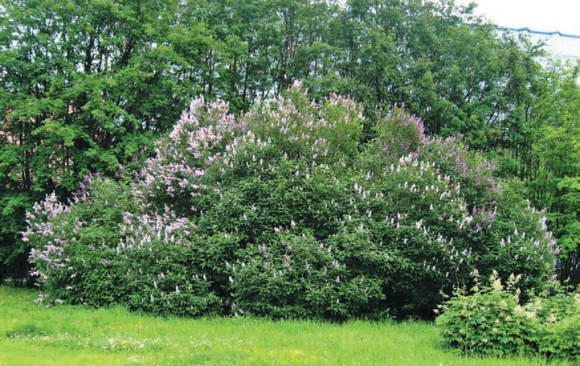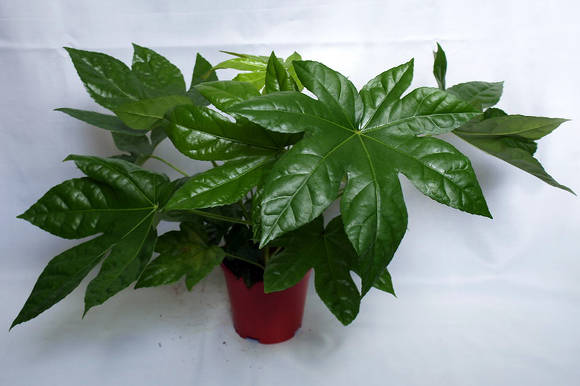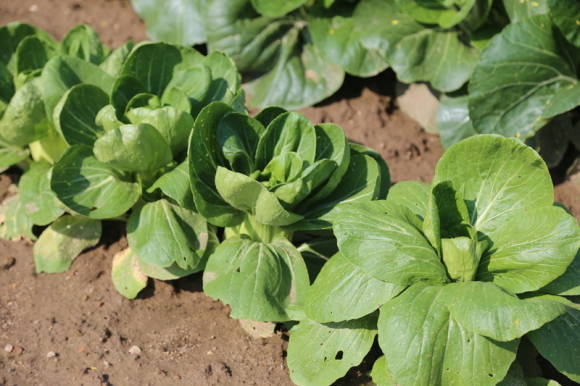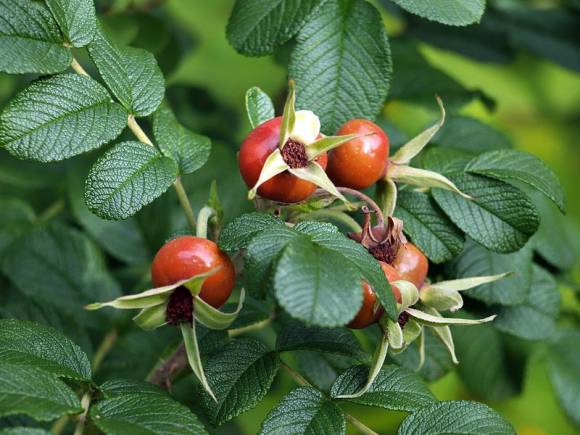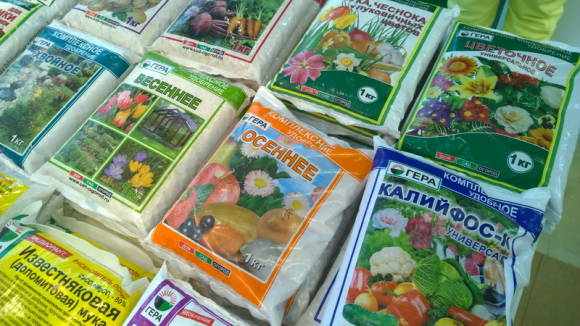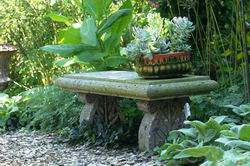Garlic is a unique vegetable: it is richer in chemical composition than all others (even onions), contains rare trace elements; its phytoncides successfully fight pathogens; with regular use, garlic prevents and helps to treat a number of diseases, including hypertension, atherosclerosis and, of course, colds; promotes the process of hematopoiesis and the normal functioning of the liver; prevents the formation of blood clots in blood vessels. Well, what about without this vigorous vegetable in the kitchen? Without it, the taste of everyday and festive dishes would not be so bright, and where everyone uses it for sure is when canning vegetables for the winter. Moreover, winter garlic is usually used for pickles. I propose to talk about him now. Besides, the time of its landing will come soon.
 |
Multi-germ garlic? There is also such
In addition to the usual winter garlic, which yields a harvest of very large single heads, we grow "unidentified" garlic on our site, which we call "family" among ourselves. We inherited it from a local gardener. It is very fragrant, and its taste is not as sharp as that of ordinary winter crops, it is more pleasant. And it also forms not one head, but like shallots - four or five. Of course, these heads are smaller in size than the usual ones, rather the size of a spring head, but we really like it. We also take into account the fact that we have not been successful in spring garlic recently (the variety has degenerated). Our "family" garlic is stored as long as ordinary winter garlic - about 9 months.
 |  |
The polychromaticity of garlic in our climatic zone is rather an anomaly. Most likely, this is a species of garlic from Central Asia, which mutated in a similar way during the transition to our northern conditions and retained such characteristics.
Not capricious. But there are features!
What else I like about garlic is that it is not difficult to grow it, there is no need to "dance with tambourines" over it, the main thing is to provide a well-lit area with properly prepared soil.
In the shade of a normal harvest, this vegetable will definitely not give. Therefore, the planting site should be selected away from home, outbuildings, fence and trees that can cast a shadow. If this is inevitable, and for some part of the day the garlic bed will be even in a light shade, for example, from apple trees, then the cloves should be planted less often. In this case, each plant will receive more light than with a thickened planting.
 |
As for the soil issue, garlic in these matters prefers the "golden mean" - it does not like heavy damp and infertile sandy soils, but prefers nutritious and at the same time light, permeable and non-acidic soils (pH 6-6.5). What if the soil on the site is far from this perfection? It is possible to slightly change the mechanical composition of soils and bring them closer to the properties of light loams or sandy loams by introducing, respectively, sand or clay. In clayey areas, 1-3 buckets of river sand are required per 1 sq. m. Sandy soils, on the contrary, can be enriched by bringing to the site soil rich in clay particles (and hence organic matter). All these additives should be thoroughly mixed with the soil available on the site to the depth of the shovel bayonet. In the case of claying sandy soils, there is another method, but it is more laborious: stir 5 buckets of clay in a 200-liter barrel of water, insist for a week, stirring daily; before digging, pour this amount of clay mortar on 50 sq.m of a sandy area from a watering can. This should be done twice a year - in autumn and spring, for several years.
Will you say - laborious? On a bed 1 m wide or a little more, it is quite possible to do this. Why exactly this size? So the plants will be better illuminated by the sun.
But you can reduce the increased acidity with the help of lime materials, but remember that they need to be applied not in the year of planting the crop, but in the previous year.
He does not like garlic and flooding with both ground and melted snow waters in spring. Therefore, so that it does not get wet and does not come out, it is necessary to arrange high ridges for planting (15-25 cm high).
And what he definitely loves is loosening and weeding. The soil crust should be broken up after each rainfall. We water the garlic regularly, do not allow the soil to dry out in the heat, stop watering only two weeks before harvesting.
About nitrogen and various fertilizers
The place for planting garlic should be chosen after cucumbers, zucchini, pumpkin, cabbage (of all types) - that is, crops that are demanding on nitrogen, which means that they endured a lot of this nitrogen with the crop, but phosphorus and potassium, which are so necessary for garlic, are less ... There is no need to plant garlic after onions, potatoes and root crops - these crops take out a lot of potassium from the soil. In this case, additional doses of compost will have to be added. And you certainly can't grow garlic over garlic. You can return it to its original place in 3-4 years.
 |  |
When planting, the soil must be filled with the following fertilizer composition (per 1 sq. M): 1-2 buckets of compost, 15 g (1 tablespoon) double superphosphate, 30 g (2 tablespoons) potassium sulfate and 0.5 liters of wood ash ... Better yet, use potassium monophosphate (this is the most concentrated phosphate fertilizer) as a phosphorus-potassium fertilizer. Just remember that it cannot be applied dry to the soil, only with irrigation water), the dosage is 15 g per 10 liters of water. You can also use "Complex mineral fertilizer for onions and garlic" (produced by Buisk fertilizers) - 50-60 g.
The scattered fertilizers must be thoroughly mixed with the soil during digging to a standard depth of 20-25 cm. And no manure! After its introduction, you can plant garlic only in the second year. The reason is that due to the excess of nitrogen, garlic will actively increase the green mass to the detriment of the development of the heads. As a result, they will grow loose, will be poorly stored, and the garlic plant itself will be more susceptible to fungal diseases. For the same reason, you should not feed garlic with urea and herbal infusion in the spring.
We usually don't feed garlic. We do this only when we notice that it lags behind in growth, looks weak, we use Fertika Lux complex mineral fertilizer for feeding, which contains, in addition to the main nutrients (NPK 16:20:27), microelements - 1 tbsp. spoon for 10 liters of water.
Landing subtleties
I do not advise you to buy garlic brought from the southern regions for winter planting on your site in central Russia, as well as "unnamed" planting material from abroad, in most cases from China. The latter can be distinguished by the snow-white "shirt" of the heads. It can often be found on sale in large chain shopping centers. In our difficult conditions, it is more than prone to freezing. It is better to give preference to well-known local "nameless" varieties that you can buy from grandmothers in the market or look for varietal winter garlic at garden exhibitions and fairs, as well as in proven online stores.
Before planting, the heads of standard varieties of garlic should be disassembled into cloves; for planting, select the largest ones, with shiny shells, without dark spots and cracks. Small ones will go to pickles. It happens that there are double teeth, with two tops or underdeveloped - they also need to be eaten.
We plant the heads of the "family" garlic entirely, without dividing them into cloves, we only clean them of dry scales, but keep the general integumentary scales. Cut off only the stem left during harvesting.
 |  |
After these manipulations, you need to soak the teeth, and in the case of "family" garlic - the heads, in a solution of potassium permanganate for an hour. Some gardeners advise to soak the teeth for a day, but we usually do not.
When planting, it is convenient to mark the bed with a small board. We make it the butt end of the groove across the ridge every 20 cm. We place the single teeth and heads of garlic in the grooves every 15 cm. We maintain a sufficiently large distance between the plants so that in case of prolonged rains, the clay soil dries out faster and it is convenient to "walk" along the bed with a ripper ...
As for the planting depth, the standard is 5-6 cm, that is, two heights of the clove. When planting in a groove 5-6 cm deep, there will be a layer of soil about 3-4 cm above the top of the clove. But here I want to make a digression. For example, on our site the soil is heavy, so we plant the garlic so that the "tails" of the cloves do not stick out so that the birds cannot reach them. Because gradually these teeth will still themselves be sucked into the soil. With a deeper planting, our harvest is worse. But there is also a technology in which the teeth are deepened by 10-15 cm. In this case, you do not need to wait for the planting time, but do it when it is convenient - from the end of August to the end of October. From a great depth, garlic will not germinate ahead of time, and it will endure the winter better. But in this case, remember that the depth of the treated soil layer must be at least 30 cm.
In general, the best time for planting garlic is 2-3 weeks before the onset of persistent November frosts. Recently, it is difficult to predict the vagaries of the weather, but usually in central Russia, planting begins in the first decade of October, to the north - at the very beginning of October, and in the south - closer to the end of October. It is not necessary to plant garlic before the deadline (unless you use a deep planting), so that the vegetable does not have time to sprout, and too late is unnecessary - it can die with a sharp temperature drop.
Usually, when planting, the soil is already moist enough, so we do not water the garlic.
For the winter, to protect against frost, it is advisable to mulch the garlic - with compost, peat, spruce branches, fallen leaves. We spread the dried stalks of perennial flowers in the garden. But with the arrival of the first warm days in spring, immediately after the snow melts, the mulch will need to be removed.
It's time to clean up
The harvesting time for winter garlic in our strip is usually in the last decade of July. At this time, the leaves, especially the lower ones, begin to turn yellow en masse. These lower leaves are an extension of the outer scales. And the fact that they have turned yellow is a signal that the outer scales of the heads of garlic have also "matured" - have become hardened and acquired a color characteristic of the variety. The moment of harvesting should not be missed - overripe heads will crumble into chives, and such garlic cannot be stored.
We are not afraid to be late with harvesting, because even before this moment we selectively take garlic from the garden for pickles and marinades, and we see - the garlic is ready for harvesting or it can "sit" still.
For mass harvesting, you need to choose a fine day after several days of dry weather, but not too hot. Gently dig in the garlic with a shovel, pull out the heads, remove the soil and outer covers that are heavily contaminated from them, cut off the roots and stem at a height of about 15 cm.In this form, we place the garlic under a canopy (in a woodshed), keep it there until it gets colder. Then we put it in plastic lattice boxes and put it on a tall cabinet in a city apartment near the front door - it's cooler there.
 |
Improve varieties - through air bulbs
Arrowing varieties of garlic, and winter in most cases refers to just such, it is advisable to update through air bulbs (bulbs). Plants left "for seeds" should preferably be kept in the garden until the inflorescence shell is fully revealed. By the way, those arrows that are thicker should be left for growing bulbs.
You can wait until the bulbs fully ripen, that is, put a white gauze cap on the arrow, which is about to burst, so that the bulbs themselves fall into it and are not lost in the garden.
 |
But our climate has changed dramatically lately. For example, earlier we took into account the following fact.Usually, we remove the garlic arrows when they move 5-6 cm. But if we left several arrows on the bulbs, we no longer thought about the exact determination of the time of harvesting the garlic. When the spirally twisted arrows of the garlic straightened and the wrapper on the inflorescences burst, the garlic was ready to harvest both the bulbs and heads.
But now this event is not always a signal about the degree of "readiness" of garlic for harvesting. It also happens that the heads of garlic are already ripe, but there are no bulbs yet, the wrapper of the inflorescence has not even cracked. In this case, you can cut the arrows so that their stem is more authentic, and put in water or hang upside down by these stems - they ripen perfectly, the wrapper will burst and the bulbs will appear to have increased in size.
The heads of garlic left to obtain the bulbs will not be stored; they must be eaten. The bulbs are dried together with the garlic, which will be planted, and we plant them all at the same time. Planting scheme: between the rows the same 20 cm, but between the bulbs we leave a distance of 5 cm. We plant it specially with a margin, because not all bulbs will germinate. And in the spring we remove the extra ones (we maintain a distance of 15 cm) so as not to “spoil the scheme” and not create inconveniences for ourselves with the cultivation of the soil between the plants, because we plant both adult garlic and bulbs on the same bed. In the next season, one-toothed bulbs will form from the bulbs, which, in turn, will grow into full-fledged heads of garlic the next year.
Photo by the author

